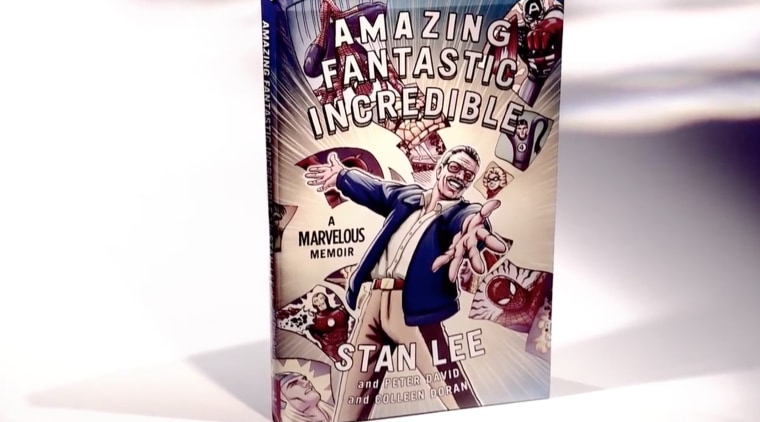With great power comes great responsibility.
Marvel comics creator Stan Lee should know after spending eight decades in the comicbook industry spinning amazing tales of superheroes who have become beloved characters, from Spider-Man to the Incredible Hulk to the Fantastic Four.
And with his 93rd birthday about a week away, the legendary Lee is sharing his own meteoric rise with his fans in a new — what better? — comicbook memoir entitled, "Amazing Fantastic Incredible."
His humble origin story begins in Manhattan during the Great Depression, when he was known as Stanley Martin Lieber.
He had a vivid imagination as a young boy, which was fueled by his love of reading; his literary influences include Jules Verne, Mark Twain, and The Hardy Boys.
His love of reading, in turn, was fueled by his mother. She loved to watch her oldest son, Stanley, read — to which he attributes his self-confidence — and encouraged him as much as she could. To this day, Lee remembers one of his early presents from his mother.
"[It was] a little stand on the kitchen table so that when I ate, I could read a book at the same time," he told NBC News. "It was a stand that you could put a book on and it held the pages open."
Related: Miles Morales Replaces Peter Parker As Spider-Man
Lee has spent his career creating an entire universe of heroes and villains, and while his creations now are ubiquitous throughout conventions and fan gatherings around the world, there was a time long ago when he was embarrassed to tell people he wrote comics for a living.
"When I got into comics, they were on the bottom of the cultural totem pole," Lee said.
As a side note on the word comicbook, Lee makes it a point to distinguish between the popularly used "comic book" and what he considers the correct phrase: "comicbook." A comic book is a book that is humorous, whereas a comicbook refers to the work that Lee says he has spent his lifetime creating. He describes the distinction with passion.

Initially, he had ambitions of writing the "Great American Novel," so when he began to publish at Timely Comics under publisher Martin Goodman, he figured he would do so under a pseudonym.
Stanley Martin Leiber became Stan Lee.
He insists that the attitude toward comicbooks changed when the comicbooks themselves changed. There was something of a seismic shift in the governing principles of creating comics, and much of that had to do with the new brand of characters that Lee created in the 1960s.
Related: Journalist Ta-Nehisi Coates to Write New 'Black Panther' Series for Marvel Comics
These characters were flawed, grounded, and complex. They lived in New York, Los Angeles, and Chicago, as opposed to the fictional cities of Batman’s Gotham and Superman’s Metropolis.
"I wanted to write about people, not about guys punching each other," Lee said.
Much of this desire to write a story about real people with depth went into the creation of one of his most iconic characters: Spider-Man.
Spider-Man’s origin is fairly inconspicuous. Lee saw an insect crawling on the wall, and thinking of a superhero with that ability stuck with him. He approached creating this new hero with the idea in mind to make him different in every way.
He made the character, Peter Parker, an awkward, lanky teenager who had little luck with women and who lived with his aunt and uncle.

While Lee was ecstatic with his creation, publisher Goodman was of a different mind.
Lee recalls the meeting with him went sour quickly, with Goodman telling him: "'This is the worst idea I have ever heard. First of all, people hate spiders so you can’t call him Spider-Man. Also, he can’t be a teenager, teenagers can only be sidekicks. And you want him to have personal problems? Stan, don’t you know what a superhero is? They don’t have problems.'"
Despite Goodman’s skepticism, Lee introduced Spider-Man in the last issue of "Amazing Fantasy," thinking it wouldn’t hurt to publish him in a magazine that was being killed anyway.
Naturally, that issue became a bestseller — at just 12 cents a pop — and changed Goodman’s mind fairly quickly.
"I wanted to write about people, not about guys punching each other."
Lee followed up Spider-Man with other iconic characters: Thor, Iron Man, the X-Men, and countless more in the 1960s alone.
Lee fondly recalls this rise of success and fame: "I was seeing ideas that I had take form on paper, in a book or magazine," he said. "And people were talking about the stories, so you couldn’t have anything better."
And so, Lee remains an unequivocal pop culture giant.
In "Amazing Fantastic Incredible," Lee traces his scrappy start in Depression-era New York through the golden age of comicbooks to Hollywood, where movies about his characters have become super-sized hits in recent years.
"I never would have expected anything like this when I was young, and I still sometimes have trouble believing it," he writes, adding, "All I was doing was trying to make a living. Then I began to enjoy writing them, so all I was doing was having fun."